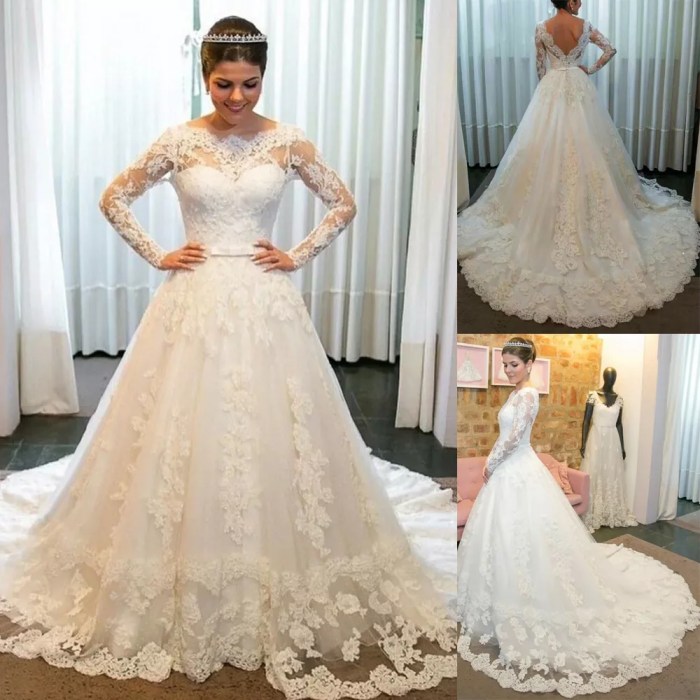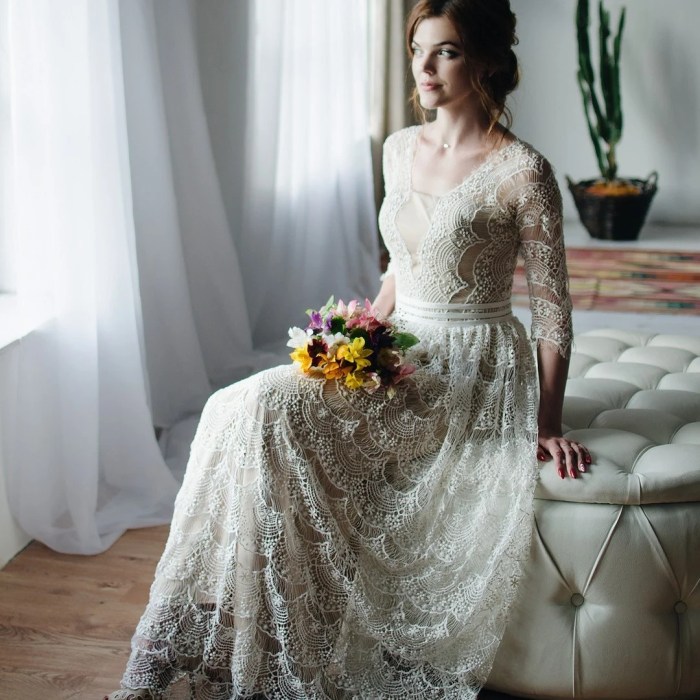A Journey Through Time: The Allure of Vintage Wedding Dresses: Women Vintage Wedding Dresses

Source: ebayimg.com
Women vintage wedding dresses – Women’s vintage wedding dresses offer a timeless elegance, often showcasing intricate details and flattering silhouettes. For a modern twist on tradition, consider pairing a vintage-inspired gown with a more contemporary reception look; perhaps a stylish alternative like the chic white mini dress wedding reception aesthetic. The contrast between classic and modern creates a unique and memorable celebration, allowing the vintage dress to truly shine as a statement piece.
Vintage wedding dresses offer a captivating blend of history, elegance, and timeless style. From the flapper-inspired gowns of the roaring twenties to the structured silhouettes of the fifties, these dresses tell a story of evolving societal norms and shifting aesthetic preferences. This exploration delves into the rich history of vintage wedding dresses, examining their design elements, the fabrics used, and their enduring appeal in contemporary fashion.
Historical Context of Vintage Wedding Dresses for Women
The 20th century witnessed a dramatic evolution in women’s wedding attire, reflecting broader societal changes and technological advancements. The styles weren’t merely aesthetic choices; they mirrored the prevailing social attitudes and economic conditions of each era.
| Decade | Characteristic Features | Influential Designers (Examples) | Notable Fabrics |
|---|---|---|---|
| 1920s | Dropped waistlines, loose, flowing silhouettes, beaded embellishments, cloche hats. | Madeleine Vionnet | Silk chiffon, beaded lace, satin |
| 1930s | Bias-cut gowns, long, elegant lines, fitted bodices, delicate detailing. | Elsa Schiaparelli | Silk crepe, satin, lace |
| 1940s | Shoulder pads, nipped-in waists, full skirts, often incorporating wartime rationing restrictions. | Claire McCardell | Wool crepe, satin, recycled fabrics |
| 1950s | Full, A-line skirts, cinched waists, often featuring petticoats for volume, long sleeves or off-the-shoulder necklines. | Christian Dior | Silk taffeta, lace, satin |
| 1960s | Shift dresses, A-line silhouettes, simpler designs, often featuring lace or embroidery. | Yves Saint Laurent | Silk, lace, cotton |
| 1970s | Bohemian styles, flowing fabrics, long sleeves, empire waists, lace and embroidery details. | Diana Vreeland (influential style icon) | Silk chiffon, lace, crochet |
Fabrics and Materials Used in Vintage Wedding Dresses

Source: etsystatic.com
The choice of fabric significantly impacted the overall aesthetic and feel of a vintage wedding dress. Each material offered unique properties, contributing to the distinct character of different eras.
- Silk: Luxurious, flowing, and available in various weights (chiffon, crepe, taffeta, charmeuse), offering versatility in design and drape.
- Lace: Delicate, intricate, and often used for embellishment or as the primary fabric, adding a touch of romance and sophistication.
- Satin: Smooth, lustrous, and often used for creating sleek, form-fitting silhouettes, adding a glamorous touch.
- Chiffon: Lightweight, sheer, and often used for overlays or sleeves, creating a dreamy, ethereal effect.
- Other fabrics: Depending on the era and availability, other fabrics like wool crepe, cotton, and even recycled materials were incorporated.
Design Elements and Silhouettes of Vintage Wedding Dresses, Women vintage wedding dresses
Vintage wedding dresses are characterized by distinct design elements and silhouettes that reflect the fashion trends of their respective eras. These features contribute to the unique charm and historical significance of these gowns.
Silhouette Examples:
1. The 1950s A-Line: A fitted bodice that gracefully flares out into a full, A-shaped skirt, often enhanced with a petticoat for added volume. This silhouette creates a youthful, romantic, and undeniably feminine look.
2. The 1920s Dropped Waist: A loose, flowing silhouette with the waistline dropped below the natural waist, creating a relaxed, carefree, and modern feel for its time. This style emphasized a slender figure.
3. The 1970s Empire Waist: A high-waisted silhouette that accentuates the bust and flows loosely over the rest of the body, typically featuring flowing fabrics like chiffon or silk. This style creates a bohemian and effortless look.
Finding and Preserving Vintage Wedding Dresses
Acquiring and preserving an authentic vintage wedding dress requires careful consideration and attention to detail. Locating a genuine piece and ensuring its longevity requires specific strategies and knowledge.
- Sourcing: Antique shops, online marketplaces (eBay, Etsy), consignment stores, and estate sales are excellent places to begin your search.
- Authentication: Examine seams, fabric quality, and construction details. Consult with vintage clothing experts or appraisers for verification.
- Preservation: Store the dress in a cool, dry, and dark place, away from direct sunlight and moisture. Use acid-free tissue paper to prevent yellowing and damage. Consider professional cleaning and preservation by a specialist.
Modern Interpretations of Vintage Wedding Dress Styles
Contemporary designers frequently draw inspiration from vintage styles, adapting classic elements to create modern and unique wedding dresses. This blending of old and new results in fresh interpretations that maintain a sense of timelessness.
- Design 1: 1920s-inspired Flapper Dress: A modern take on the dropped waistline, featuring a beaded silk chiffon gown with a fringe detail and a subtle V-neckline. Inspiration: The loose, flowing silhouette and beaded embellishments of the 1920s flapper dresses.
- Design 2: 1950s-inspired A-Line Gown: A contemporary A-line silhouette crafted from luxurious satin, with a fitted bodice and a full skirt, incorporating delicate lace appliqués on the bodice. Inspiration: The classic A-line shape and full skirt of 1950s wedding dresses.
- Design 3: 1970s-inspired Bohemian Gown: A flowing empire waist gown made from delicate silk chiffon, featuring intricate embroidery and long sleeves. Inspiration: The bohemian aesthetic and flowing fabrics of 1970s wedding dresses.
The Cost and Value of Vintage Wedding Dresses
The price of a vintage wedding dress is influenced by several factors, making it crucial to understand the market dynamics and potential for appreciation.
- Factors Affecting Price: Designer, condition, age, fabric, and rarity all play a role in determining the cost.
- Cost Comparison: Vintage dresses can range significantly in price, sometimes offering a more affordable alternative to new designer gowns, while others can command a premium price.
- Appreciation Potential: Well-preserved dresses from renowned designers or representing significant historical periods can appreciate in value over time, becoming valuable collector’s items.
Top FAQs
How do I clean a vintage wedding dress?
Professional dry cleaning is strongly recommended for vintage wedding dresses. Avoid home washing or harsh chemicals.
Where can I find vintage wedding dress patterns?
Online marketplaces like Etsy and eBay, as well as vintage fabric stores and pattern archives, are good sources.
Are alterations possible on a vintage wedding dress?
Yes, but it’s crucial to find an experienced seamstress specializing in vintage garments to avoid damage.
How can I tell if a vintage wedding dress is authentic?
Look for hallmarks like original labels, construction techniques, and fabric types consistent with the era. A reputable vintage seller can provide authentication.

